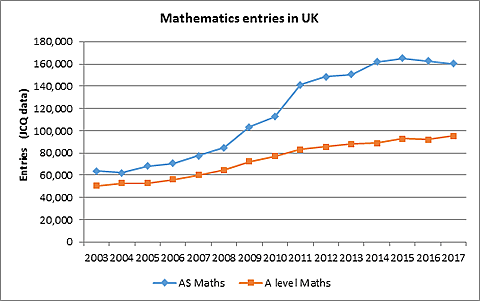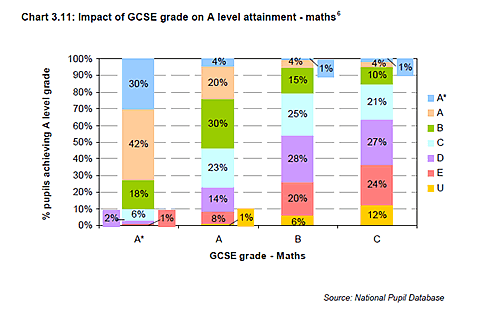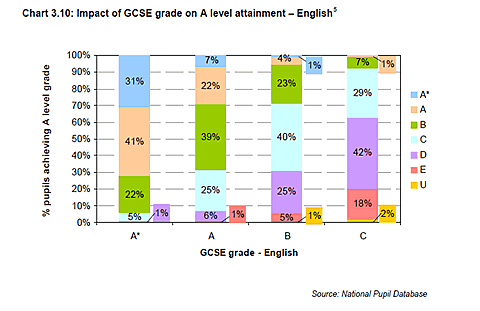Reflections on the uptake of AS/A level Maths, AS/A level Further Maths and Core Maths
An article from our Director, Charlie Stripp
19/09/2017

Increasing participation in AS/A level Maths and Further Maths is very close to my heart. In 2000 I joined the maths education charity, MEI, to develop and run a pilot programme to raise levels of participation in A level Further Maths, which eventually led to the Further Maths Support Programme, and I have continued to be involved in leading this work ever since.
Raising participation is a complex issue involving many factors, and the changes to maths education we are currently going through make it even more complex than before. However, I think there are grounds for optimism.
This summer’s AS/A level entry figures were really excellent news for maths. The graphs below show how participation in AS/A level Maths and Further Maths have increased since 2003:
The upturn in AS Further Maths entries this year is both surprising (because changes to the structure of A levels meant numbers fell for every other mainstream subject) and heartening. Universities recognise AS Further Maths as a useful qualification, supporting transition to many STEM degrees, especially Engineering and Physics, as well as Maths, and the FMSP is encouraging more universities to promote AS, as well as A level Further Maths to prospective undergraduates.
However, the current combination of the significant changes to the GCSE and A level Maths qualifications, the de-coupling of AS and A levels and funding pressures on schools and colleges means we cannot assume these trends will continue. An important impact of the de-coupling of AS and A level, combined with funding pressures, is that many schools and colleges are now offering only three, rather than four, subjects to A level students from the start of year 12. This is a particular concern for Further Maths uptake, because it is normally taken as one of four AS/A level subjects. For this reason, schools and colleges should treat Further Maths as a special case and allow students to take Further Maths as one of four AS/A levels.
Core Maths was examined for the second time this summer and numbers have increased significantly, from just under 3000, to around 5400, which is also excellent news, meaning that more young adults have stronger mathematical and statistical skills. Core Maths is valuable for any student with GCSE Maths at grade 4 or above who does not intend to take AS/A level Maths, and it has a potential cohort of many tens of thousands, but schools, colleges and teachers will need considerable support to expand participation further.
The publication of Professor Sir Adrian Smith’s review of post-16 mathematics is very welcome. It includes several recommendations that help to address these concerns. The review emphasises strongly the importance of continuing to increase participation in AS/A level Maths and Further Maths, and of raising participation in Core Maths, so that a far greater proportion of our young people study maths to beyond GCSE standard (‘level 3’) by age 18. It highlights the need to address funding concerns, extend PD opportunities and tackle other barriers to raising participation, including regional variations and low participation by girls (currently, girls make up around 40% of A level Maths students, and around 30% of A level Further Maths students, while 55% of all A levels taken in 2017 were taken by girls)
A long-standing frustration for me in trying to increase participation in AS/A level Maths and Further Maths has been schools and colleges choosing to impose high ‘entry requirements’ for students to embark on these courses. I believe that a student with a strong pass (grade 5 or above) on the new GCSE Maths should be entitled to the opportunity to study AS/A level Maths. The Smith Review includes the stark statistic that, in 2015/16, 92% of students who entered A level Maths had achieved an A or A* grade in GCSE Maths, whereas just 53% of students entering English Literature A level achieved an A or A* in English at GCSE. This is caused mainly by large numbers of schools and colleges imposing high GCSE Maths grade ‘entry requirements’ for students to embark on AS/A level Maths courses, and I believe it is very damaging. There will also be a ‘self-selection’ effect, but if schools and colleges aren’t encouraging students with B grades or equivalent to choose AS/A level Maths, they will be influencing students’ self-selection too.
A level grades in Maths and Further Maths are hugely negatively skewed. In A level Maths this summer, 42.3% of students achieved an A or A* grade. In Further Maths this figure was 58.1%. The corresponding figure for English Literature was 24.3%; for Physics it was 29.2%. The Maths grade profiles are so negatively skewed because students taking A level Maths and Further Maths tend to have disproportionately high GCSE grades for the reasons described above. Schools and colleges have justified their actions by suggesting that only top grade GCSE students can succeed in AS/A level Maths, though the data suggest otherwise.
The latest national data I am aware of on the performance of students with different GCSE Maths grades in Maths A level1are from 2010; these are shown below, along with the corresponding graph for English, for comparison. In that year 44.8% of students got A or A* grades in A level Maths, compared to 23.1% in English Literature, much the same as now. These data certainly suggest that students with lower GCSE Maths grades can succeed at A level Maths. A grade D or E in AS/A level Maths can represent success for many students, opening opportunities for further study.
If schools and colleges had encouraged more students with grade B in GCSE Maths to begin AS/A level Maths and Further Maths in 2015, far more students could have taken it this summer and it is likely that the grade profile would have looked more like that of other A levels.
This summer saw the first cohort of students sit the new GCSE Maths, graded on the 9 – 1 scale. The new GCSE Maths has been designed to be more demanding than the previous version, and to provide a better preparation for higher level study in maths, so students with a strong pass should be better prepared than ever to progress to AS/A level Maths.
I would like schools and colleges to view the new GCSE Maths as an opportunity to rethink their entry requirements, recognising the more rigorous mathematical background students with grades 5 and 6 now have. When the GCSE Maths results came out, I published advice for schools and colleges and advice for students to encourage a wider range of students to progress to level 3 maths post-16, and to encourage schools and colleges to give them the opportunity to do so. If this advice is followed, far more students will benefit from level 3 maths.
The new Level 3 Maths Support Programme, announced by the DfE in response to the Smith review, will replace the Further Maths Support Programme, probably starting from April 2018, building from the work of the FMSP and CMSP to provide a coherent programme to support the teaching and learning of Core Maths and AS/A level Maths and Further Maths. I hope the new programme will be able to provide advice, support and professional development to help schools and colleges to enable students with a wider range of GCSE Maths grades to succeed in Core Maths, AS/A level Maths and Further Maths, and to address regional, social and gender inequalities in the uptake of level 3 maths.
From this September, the FMSP and the Maths Hubs will continue to do all they can to support Level 3 maths. In the longer term, the Level 3 Maths Support Programme, working with the Maths Hubs, can lead the drive to increase participation in maths at this level. I hope that, over the coming years, this can develop our level 3 maths provision so that far more of our young people will be able to access the post-16 maths education they need to support their future aspirations, which would also boost the economic competitiveness of our country. Another consequence would be that the grade profiles for the Maths and Further Maths A levels would be rather less negatively skewed.
Some crude modelling is revealing:
- If the number of girls taking A level Maths this summer had been the same as the number of boys, instead of 95 000 A level Maths students there would have been 116 000. For A level Further Maths, 16 000 would have become 23 000.
- For the sake of argument, if we assume 95% of GCSE Maths grade 9 students, 90% of grade 8s, 70% of grade 7s, 50% of grade 6s and 20% of grade 5s were to choose A level Maths, based on this summer’s GCSE results this would mean that in 2019 around 135 000 students would take A level Maths, rather than the current 95 000, and 63% of the A level Maths cohort would have grades 7, 8 or 9 (equivalent to A/A*), rather than the 92% quoted in the Smith review for 2016 - still a strong negative skew, but more in line with other subjects.
- If we also assume 60% of grade 9s, 40% of grade 8s, 15% of grade 7s and 5% of grade 6s also took A level Further Maths, that would result in around 35 000 students taking A level Further Maths, rather than the current 16 000.
Obviously, these are very rough calculations, but they show what might be possible.
If your school or college adopted a policy of allowing B and possibly C grade students to take A level Maths in the past, I’d be very interested to hear of your experiences and future plans. Similarly, if you have a relatively even gender balance in your AS/A level Maths/Further Maths classes, what do you feel enabled you to achieve that?
1 DfE 2012 (reporting on A level results in 2010)



